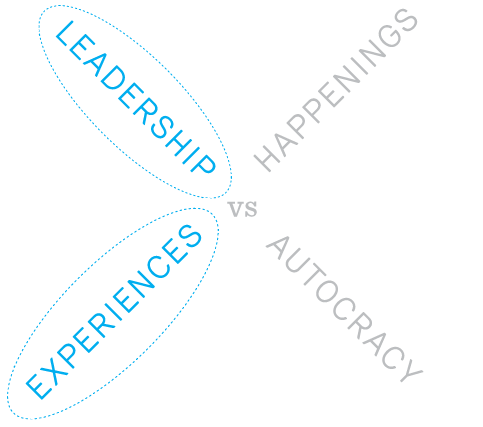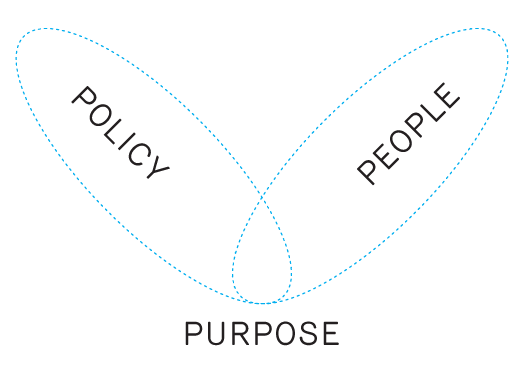Leading by Community
Having seen the power of the open source community first-hand, I am of the opinion that the fastest way to innovate involves setting free the collective intelligence of your community.
Your community may be your team, your company, your customers, or anyone who can identify with others through a common passion. Successfully leading a community takes an approach that comes from the inside-out, not top-down. It’s less about the individual and more about what we can all achieve together.

Leadership versus Autocracy
Often we have a misconstrued notion of what it means to be a leader. We are still working with the ideas of what it took to succeed in the industrial age, despite having clearly moved past that. Success today is about innovation, not stamping out one widget after another. If we lead with industrial age thinking we will kill innovation where we stand.
Unfortunately this industrial age thinking has ingrained into us the idea that autocratic leadership equals strong leadership. All autocracy does is give us someone to blame for failures (and thus declare our own innocence). The problem with an autocratic leader is that they have no way to continue that style of leadership while contributing to our community.
The real task of leadership is to confront people with their freedom
Think about it. With an autocracy we sit back and wait for one individual to bring “The Great Idea” out of the darkness to solve all our problems. We certainly think that way with our political leaders—our Presidents or Prime Ministers need to have the answers to get elected. Once they prove not to be able to do it alone, we then blame them for all that is wrong.
This thinking ignores our collective minds and spirit! We feel less like contributing as we wait for our the next hero to fix all our ills.
True freedom, in work or citizenry, is the choice to be the creator of our own experience. When we are free to choose our own freedom, we create accountability as a side effect… no matter what popular culture might lead us to believe.
Experiences versus happenings
Most people do not accumulate a body of experience. Most people go through life undergoing a series of happenings which pass through their systems undigested. Happenings become experiences when they are digested, they are reflected upon, related to general patterns, and synthesized.
If leading by autocracy stifles innovation, leading by community brings spirit and creativity to the forefront. The best insights come from the collective mind of a community deep in cooperation. So how do you build a collaborative community within your organization?
One simple approach is to start with a small group of committed people. Hand select them if it seems best, but allow anyone who has a desire to join to participate. Do make sure this group is representative of the organization as a whole. This group’s function is to reflect on solutions. You may have a particular problem, or a range of them. This group will reflect on them—and only reflect. You’ll be surprised by how much further they will go past reflection when trusted, and left alone.
Make sure the group has a place to record their insights. A file, a book, a wall, anywhere. When there are no more insights to record you’ll find you now have a map of the problem and insights that can become a strategic road-map out.
Your upper hierarchy is not responsible for these strategies and insights, the group is. As a leader you must buy into their solutions for it to work. The group starts taking ownership of the issues and becomes the model for leadership.
What you are trying to create is interest in working together to address problems. To do this leadership must come from the community itself. It shows the rest of the community (company, team) that individuals can contribute to leadership.
The real obstacle to this approach tends to be community norms that have built up over time placing restrictions on the methods the community uses to interact with each other. Make this group the declaration of war against those restrictions—everyone has a voice.
The gift you are giving to your organization is the gift of freedom. With that freedom will come accountability and collective intelligence. All of this leads to innovation.
Postscript: the Three P’s

To lead by community there needs to first be a community. As a teaser to get you started on creating or identifying a community, keep Jenny Preece’s Three Ps in mind. Here is my take on those:
Purpose
What is it that draws people into your community? Even casual participants join for a reason. State your purpose as a community up front. Stake your claim. A community with a clearly stated goal will attract the right people.
People
People relate to their place within a community when they understand the roles of participants. Be aware of the type of persona your community members fit into. Now measure it. Be active in giving your most dedicated members leadership roles like moderator or mediator.
Policy
Communities need policies to direct their behavior. Determine the requirements to join, the style of communication (tools), accepted conduct, and repercussions of non-conformance. State these up front to every participant. Then determine how your community will be governed. Make sure the leaders address such things as: by-laws, rules for moderation, privacy and trust, and legal issues.
Quiet managers strengthen the cultural bonds between people, not by treating them as detachable “human resources” (probably the most offensive term ever coined in management, at least until “human capital” came along), but as respected members of a cohesive social system. When people are trusted, they do not have to be empowered.
Leadership is still about being decisive and inspiring. This isn’t about leading by committee. This is about bringing talented people together to collectively solve problems. This is about showing your community their freedom and allowing them to take ownership in the direction of the organization. Finally, this is about allowing innovation to happen.